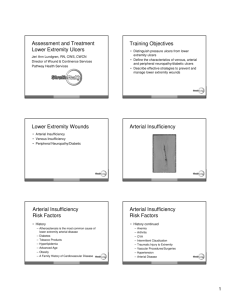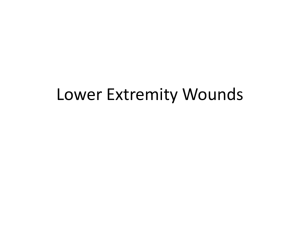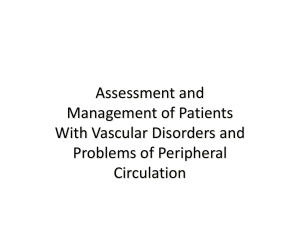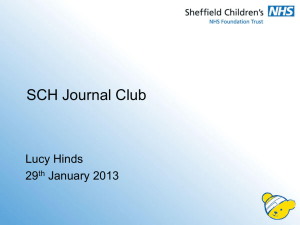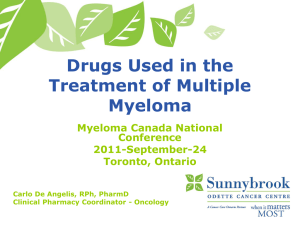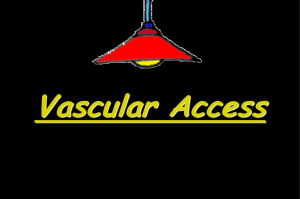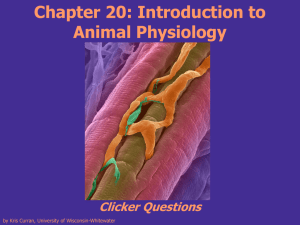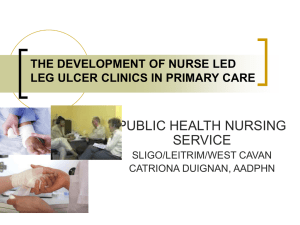Determining the Etiology of Wounds Pressure Ulcers
advertisement
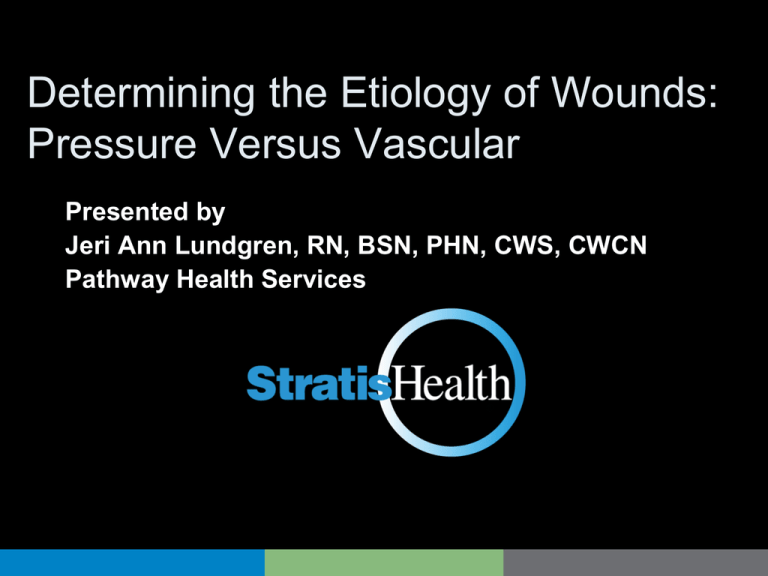
Determining the Etiology of Wounds: Pressure Versus Vascular Presented by Jeri Ann Lundgren, RN, BSN, PHN, CWS, CWCN Pathway Health Services Training Objectives • Describe etiologies of Pressure Ulcers • Discuss the pressure versus other causes of wounds • Demonstrate how to determine vascular wounds from pressure ulcers Pressure Ulcers • A pressure ulcer is localized injury to the skin and/or underlying tissue usually over a bony prominence, as a result of pressure, or pressure in combination with shear and/or friction Copyright: NPUAP 2007 Pressure Ulcers Pressure Ulcers Contributing Factors: Shear Contributing Factors: Shear Contributing factors: Friction Contributing factors: Friction Lower Extremity Wounds Arterial Insufficiency Venous Insufficiency Peripheral Neuropathy/Diabetic Arterial Insufficiency Arterial Insufficiency Extremity becomes pale/pallor with elevation and has dependent rubor Skin: shiny, taut, thin, dry, hair loss of lower extremities, atrophy of subcutaneous tissue Increased pain with activity and/or elevation (intermittent claudication, resting, nocturnal and positional) Arterial Insufficiency Perfusion –Skin Temperature: • Cold/decreased –Capillary Refill • Delayed – more than 3 seconds –Peripheral Pulses • Absent or Diminished Arterial Insufficiency Tests Ankle Brachial Index (Doppler) < 0.8 Systolic Toe Pressure (Doppler) TP < 30 Transcutaneous Oxygen Pressure Measurements (TcPo2) TcPo2 < 40 mm Hg Arterial Insufficiency Ulcers Location • Toe tips and/or web spaces • Phalangeal heads around lateral malleolus • Areas exposed to pressure or repetitive trauma (shoe, cast, brace, etc.) Arterial Insufficiency Arterial Insufficiency Venous Insufficiency Venous Insufficiency Lower Leg characteristics – Edema Pitting or non-pitting – Venous Dermatitis (erythema, scaling, edema and weeping) – Hemosiderin Staining Brown staining (hyperpigmentation) – Active Cellulitis Venous Insufficiency Pain Minimal unless infected or desiccated Peripheral Pulses Present/palpable Capillary Refill Normal-less than 3 seconds Venous Insufficiency Ulcers Location –Medial aspect of the lower leg and ankle –Superior to medial malleolus Venous Insufficiency Venous Insufficiency Peripheral Neuropathy/Diabetic History • • • • • • • • Diabetes Spinal cord injury Hypertension Smoking Alcoholism Hansen’s Disease Trauma to lower extremity Family history ***Please note that there are over 100 known causes Peripheral Neuropathy/Diabetic Relief of pain with ambulation Parasthesia of extremities Altered gait Orthopedic deformities Reflexes diminished Altered sensation (numbness, prickling, tingling) Peripheral Neuropathy/Diabetic Intolerance to touch (e.g., bed sheets touching legs) Presence of calluses Fissures/cracks, especially the heels Arterial insufficiency commonly co-exists with peripheral neuropathy! Peripheral Neuropathy/Diabetic Light pressure using a Semmes-Weinstein Monofilament Exam Vibratory sense using a tuning fork Deep tendon reflexes of ankle and knee Recommend an ABI as arterial insufficiency commonly co-exists Peripheral Neuropathy/Diabetic Plantar aspect of the foot Metatarsal heads Heels Altered pressure points Sites of painless trauma and/or repetitive stress Peripheral Neuropathy/Diabetic Peripheral Neuropathy/Diabetic Moisture-Not Pressure Intertrigo Wounds NOT Caused by Pressure Resources • Available Resources and Web Sites: – www.wocn.org (Wound, Ostomy & Continence Nurse Society) – www.ahrq.gov (Agency for Health Care Research and Quality, formally AHCPR) – www.aawm.org (American Academy of Wound Management) – www.npuap.org (National Pressure Ulcer Advisory Panel) – www.woundsource.com (Great source to find wound care products) Thanks for your participation!!! Jeri Lundgren, RN, BSN, PHN, CWS, CWCN Pathway Health Services jeri.lundgren@pathwayhealth.com Cell: 612-805-9703 This material was prepared by Stratis Health, the Quality Improvement Organization for Minnesota, under a contract with the Centers for Medicare & Medicaid Services (CMS), an agency of the US Department of Health and Human Services. The contents presented do not necessarily reflect CMS policy. 10SOW-MN-C7-11-39 011012
